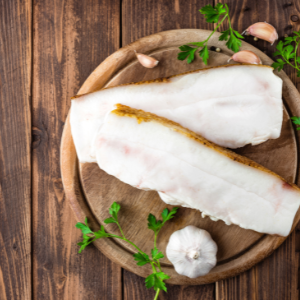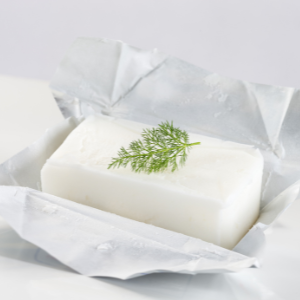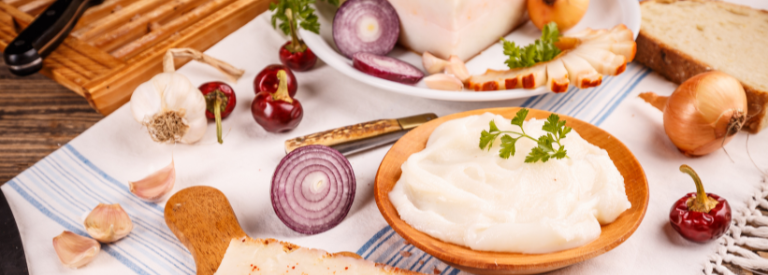A lot of people tend to disassociate lard as an important role in the kitchen. Many tend to avoid it due to its unhealthy reputation or being an old baking trick. A star ingredient in Latin cuisine or Southern food, more cooks are transitioning from their butter or vegetable shortening to lard. If you have no idea what lard is, then you are probably thinking, what exactly is lard and how can I use it? This lard guide features all the questions you may have about this secret ingredient.
What is Lard?
Lard is melted pig fat that is used for cooking, baking, and deep frying. It is a creamy white color which can be flavorless & odorless depending on the kind of lard you use. Lard is a vital ingredient in the majority of Latin and Southern Cuisine, like fried chicken, tamales, pie crust, biscuits, donuts, and even Cuban bread. It’s what causes these delicious dishes to melt in your mouth.
What is Lard Made Out Of?
Lard is made from 100% animal fat, usually pork. The fat is taken out of the meat and formed through the rendering process. The rendering process is when the fatty parts of the pig are cooked slowly until that fat is melted. After fat is melted, it is then chilled to solidify into a white creamy texture. Essentially, lard should be flavorless and odorless, but depending how the lard is made it can have a lingering pork taste or smell.
How To Use Lard
Lard is a great choice to use in baking, roasting, sauteing, grilling, or frying. To prevent your recipes from any lingering pork flavor, it’s best to use rendered or processed lard. Due to its solid form, it can be used like butter and added to any sort of baking recipes.
Is Lard Bad For You?
Lard is a fat to avoid if you're vegetarian or vegan. For those with
milk allergies or who are lactose intolerant, lard can be added in their
recipes due to its dairy-free components. Compared to other fats, such
as butter or olive oil, lard is examined to be a healthier option. Lard
contains zero trans fat but that doesn’t mean it should be consumed on a
daily basis - everything in moderation.
Benefits of Lard
It may be hard to believe that rendering pork fat has benefits, but this is only a misconception. Below are a few interesting benefits consuming lard gives us.
- High source of Vitamin D: Fights against cancer
- Rich In Monounsaturated Fats: Lowers cholesterol and heart disease
- Choline: Helps prevent Alzheimer’s and liver disease
Types Of Lard
All lard is quite different, though they all derive from the fat of the pig. Each lard is different depending what part of the pig you extracted the fat from and how you made it.
- Rendered Lard: Popularly known for not having a lingering pork flavor. Comes with 100% pork fat that is filtered and chilled.
- Unrendered Lard: Pig fat that has been trimmed from the meat. It is not filtered or melted and has a pork taste. Not recommended to use in sweet treats or pie crusts.
- Processed Lard: Filtered & clarified. Highly preferred due to no lingering pork flavor. Is bleached and hydrogenated. Contains preserves.
- Leaf Lard: Considered a luxurious lard. Comes from the leaf shaped fat around the kidneys and abdomen areas. This lard is softer and smoother, ideal for baking due to its creaminess.
How To Make Lard
Things You Will Need:
- Any cold lard of your choice or back fat
- Slow cooker or large pot
- Colander
- Cheesecloth
- Storage container to chill
Time To Make Magic
The goal is to have a neutral flavor in your using it to bake sweet treats or crusts. Remember to cook in low heat to avoid that strong flavor that can affect the taste of your pastries. If planning to fry with lard, then it is easier to get away with that pork flavor it can have.
- Dice your fat into small pieces, the smaller the shape the quicker it will render.
- With a large pot, you can render lard on the stove or the oven. In the oven, heat to 225-250 degrees F.
- On the stove, cook on medium-low heat and then transition to the lowest heat setting once it begins to melt.
How To Store Lard
Traditionally, lard was kept at room temperature for up to a year without going bad. However, it is recommended to store in a fridge and will preserve itself for at least 6 months to a year. You can even freeze it in bars, cubes, or in glass jars to store longer. If a sour smell appears, then it means it's time to throw it out and make a new one.
Alternatives To Lard
Struggling to find or make lard? Below are a couple alternatives you can use to substitute lard.
- Shortening: Made out of 100% fat, just like lard. Use at a 1:1 ratio.
- Butter: Butter is made out of 80% fat, and since it has less fat than lard, you will need more of it. Use a 1:4 ratio of butter plus 1 tablespoon.
- Oils: For coconut and olive oil, use a 1:1 ratio. If using vegetable oil, use a 7:8 ratio.
Give This Old Baking Trick A Shot
Making a comeback in the culinary world, lard has been used way before refrigerators were invented. With this throwback ingredient, you will surely make your family or guests mouths water, but it’s important to keep in mind that the kind of lard you use could affect the overall taste of your dish. Lard is considered a healthy option compared to your usual butter or olive oil, but should not be the reason to completely steer away from them. Next time you decide to make pie, give lard a try!






